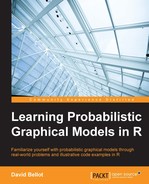In this chapter we saw how to compute the parameters of a graphical model by using the maximum likelihood estimation.
The reader should note however that this approach is not Bayesian and could be improved by setting prior distributions over the parameters of the graphical models. This could be used to include more domain knowledge and help in obtaining better estimations.
When the data is not fully observed and variables are hidden, we learned how to use the very powerful EM algorithm. We also saw a full implementation of a learning algorithm in R for a fully observed graph.
We would like, at this point, to encourage the reader to use the ideas presented in this chapter to extend and improve his or her own learning algorithms. The most important requirement when doing machine learning is to focus on what is not working. From a dataset, any algorithm will, at some point, extract some information. However, when one focuses on the errors in an algorithm and where it does not work, one will really find value in the data.
In the next chapter, we will look at several simple, yet powerful Bayesian models that can be represented as graphical models. We will see that some of them can be highly optimized for inference and learning. We will also explore an application of the EM algorithm to find clusters in data, using Gaussian mixture models.
